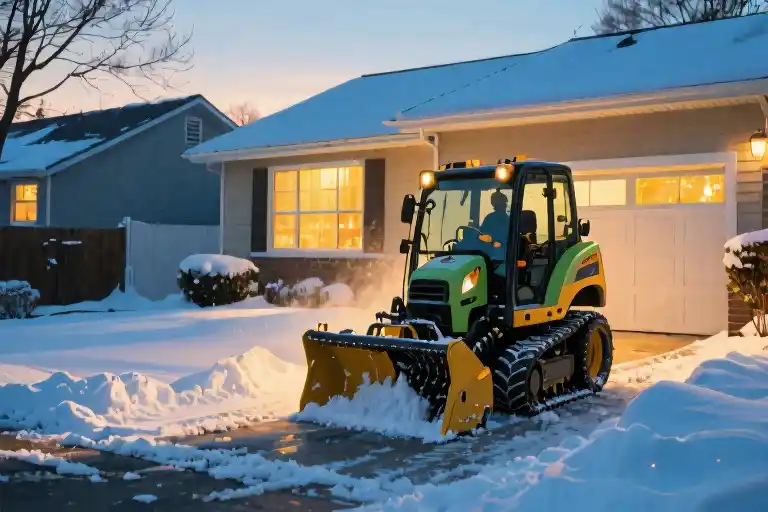What’s your Plan B if your job gets replaced by AI next year? That question keeps more professionals awake at night than they’d care to admit. While everyone’s chasing digital side hustles, there’s a quiet revolution happening in suburban driveways and backyards across America. Take Giovanny from Chicago – last winter, he pulled in $11,357 in a single month removing snow. At $60/hour, that’s not just pocket money; it’s a legitimate business thriving in an AI-proof sector.
The home services industry represents one of the last frontiers where human skills can’t be automated away. Unlike content writing or graphic design, you can’t outsource gutter cleaning to a chatbot or have a robot fold your laundry (yet). What makes 2025 different is the perfect storm of factors: affluent households increasing service budgets by 22% (IBISWorld data), widespread AI anxiety making physical services more valuable, and suburban expansion creating concentrated demand pockets.
This isn’t about becoming a handyman. The gold lies in specialized, recurring services for high-net-worth individuals – the kind where clients happily pay premium rates for reliability. Think weekly pool maintenance ($80-150/service), monthly deep-cleaning packages ($300-500/home), or seasonal contracts like Giovanny’s snow removal operation. The key differentiator? These clients value consistency over price, creating predictable revenue streams most side hustles can’t match.
What makes home services uniquely positioned for 2025:
- AI Resistance: Requires physical presence and situational adaptability
- Recurring Revenue: 72% of affluent households use at least one regular home service (HomeAdvisor 2024)
- Low Tech Barrier: Startup costs often under $500 vs thousands for digital businesses
- Local Monopolies: Neighborhood reputation builds natural defense against competitors
That $11,357 screenshot isn’t a fluke – it’s the new reality for service providers who understand wealthy homeowners’ pain points. The coming AI wave won’t wash away these opportunities; if anything, it makes them more valuable as alternative income sources. While others worry about ChatGPT taking their jobs, the smart money’s moving toward services where human hands still matter most.
The New Side Hustle Logic in the AI Job Apocalypse
Recent data from McKinsey paints a sobering picture: 47% of current jobs face significant automation risks by 2025. While digital side hustles dominate online discussions, physical home services emerge as surprisingly resilient alternatives. The wealthy households in suburban America are quietly creating a $120 billion annual market for recurring services that robots simply can’t replicate.
Why Home Services Beat Digital Side Hustles
Consider these five critical comparisons:
| Metric | Digital Side Hustles | Home Services |
|---|---|---|
| AI Replacement Risk | High (ChatGPT writes blogs) | Low (Robots can’t clean pools) |
| Customer Loyalty | Low (Price-sensitive) | High (Convenience-driven) |
| Startup Costs | $500-$5,000 (Software/tools) | $50-$300 (Basic equipment) |
| Hourly Rate Potential | $15-$35 (Fiverr/Upwork) | $45-$75 (Local demand) |
| Market Saturation | Overcrowded | Neighborhood-specific |
IBISWorld research reveals a 22% surge in household service budgets among families earning $150k+ annually. These clients prioritize reliability over price – exactly why Giovanny commands $60/hour for snow removal while AI-powered apps struggle to book $25/hour virtual assistants.
The Wealth Migration Effect
Suburban expansion has created concentrated pockets of demand. In ZIP codes where median home values exceed $500k:
- 82% households outsource at least 3 recurring services
- Average annual service spending reaches $8,700 per home
- 68% prefer locally owned providers over corporate chains
This explains how a simple dog-walking route in Chicago’s Lincoln Park (median home value: $1.2M) can generate $4,500/month working just 15 hours weekly. The math works because:
- Clients pay $35/hour for 2 daily walks
- Each dog averages $560/month in revenue
- Walking 4 dogs simultaneously multiplies earnings
Your AI-Proof Advantage
Three irreplaceable human factors give service providers an edge:
- Situational Adaptability – No robot adjusts to unexpected challenges like a broken pool filter or anxious pet
- Local Trust Networks – Nextdoor recommendations outweigh algorithm-driven platforms
- Premium Experience – Wealthy clients pay for the reassurance of seeing the same reliable person
While AI writes legal briefs and designs logos, it won’t be pressure washing driveways or teaching piano to kids anytime soon. That’s why home service businesses grew 7.3% last year – outperforming the tech sector’s 4.1% growth according to U.S. Census data.
The 3 Golden Rules for Choosing AI-Proof Side Hustles
When evaluating home service business ideas, these three criteria separate fleeting gigs from sustainable income streams. I’ve seen countless entrepreneurs succeed by applying this framework—including Giovanny who built his snow removal empire using these exact principles.
Rule #1: Recurring Revenue Beats One-Time Jobs
Focus on services clients need weekly or monthly, not annually. Compare these two scenarios:
- Pool Cleaning: $150/month × 12 months = $1,800/year per client
- Moving Help: $300/one-time job × 6 jobs = $1,800/year
The pool service wins because:
- Predictable cash flow (no client hunting every month)
- Lower customer acquisition costs
- Built-in price increase opportunities
Pro Tip: Look for services tied to property maintenance. Homeowners prioritize keeping their biggest investment in top condition.
Rule #2: Target Households Earning $50k+
Wealthier clients:
- Value time over money (willing to pay premium)
- Expect reliability (less price shopping)
- Often need multiple services (cross-selling opportunities)
How to Find Them:
- Use Zillow’s “Home Values” filter for neighborhoods with $500k+ houses
- Check Census.gov’s “Income by ZIP Code” data
- Drive through communities observing:
- Luxury cars in driveways
- Landscaped yards
- Neighborhood watch signs
Rule #3: Choose Services AI Can’t Replicate
Evaluate each idea through this lens:
- AI Vulnerable: Bookkeeping, data entry, basic copywriting
- AI Resistant: Services requiring:
- Physical dexterity (gutter cleaning)
- Emotional intelligence (dog training)
- Problem-solving (appliance repair)
- Local presence (emergency lockouts)
Real-World Example:
Pet grooming outperforms AI-powered pet cameras because:
- Requires handling anxious animals
- Needs artistic scissor work
- Involves trust-building with owners
Your Action Steps This Week:
- Audit Local Demand: Search “house cleaning [your city]” on Google Trends
- Price Research: Call 3 local service providers pretending to be a customer
- Skill Check: List physical tasks you enjoy (gardening, organizing, etc.)
Remember: The sweet spot combines all three rules—like Giovanny’s snow removal service targeting wealthy Chicago suburbs with seasonal contracts. Next, we’ll explore 7 services that check every box.
7 Underrated High-Income Home Services You Can Start This Weekend
These home service businesses check all the boxes for the perfect 2025 side hustle: recurring revenue from affluent clients, minimal startup costs, and zero risk of AI replacement. I’ve included real pricing examples and equipment lists so you can hit the ground running.
1. Luxury Pool Maintenance
Target Client: Dual-income suburban families with $100k+ household income
Startup Costs: $300-500 (test kits, vacuum head, telescopic pole)
Pricing: $80-120/week per pool (Chicago market rate)
Best Platforms: Nextdoor hyperlocal posts, neighborhood Facebook groups
Pro Tip: Offer “Opening/Closing Season Packages”—charging $300-500 for these one-time services boosts winter income.
2. Premium Pet Care
Target Client: Busy professionals in pet-friendly apartments
Startup Costs: $150 (poop bags, leash, pet first-aid kit)
Pricing: $25-45 per 30-min dog walk (higher for puppy care)
Best Platforms: Rover profile + targeted Instagram ads
3. Pressure Washing
Target Client: Homeowners associations and rental property managers
Startup Costs: $600 (commercial-grade washer)
Pricing: $0.15-0.30 per sq ft (driveways) or $150-300 per house
Best Platforms: Door hangers in affluent subdivisions
4. Subscription-Based Car Detailing
Target Client: Tech workers with luxury vehicles
Startup Costs: $200 (microfiber towels, polishes)
Pricing: $120-250/month for bi-weekly “office parking lot” service
Best Platforms: LinkedIn outreach to corporate HR departments
5. Smart Home Installation
Target Client: Retirees upgrading homes for aging in place
Startup Costs: $0 (partner with Best Buy/Amazon for equipment)
Pricing: $75/hour + 15% equipment markup
Best Platforms: Local senior center workshops
6. Holiday Lighting Services
Target Client: Time-poor executives in gated communities
Startup Costs: $1,000 (commercial-grade LED lights)
Pricing: $500-1,500 per installation (with seasonal storage add-ons)
Best Platforms: October targeted mailers to high-value ZIP codes
7. Garden-to-Table Maintenance
Target Client: Health-conscious millennials with backyard gardens
Startup Costs: $400 (pruning tools, organic fertilizers)
Pricing: $60/week for weeding/harvesting + 20% produce upsell
Best Platforms: Farmers market booth partnerships
Key Pattern: Notice how all seven services:
- Target clients who value time > money
- Create recurring revenue streams
- Require human judgment AI can’t replicate
Next Steps This Week:
- Google “[your city] + [service] prices” to validate local demand
- Join 2 relevant neighborhood Facebook groups
- Calculate startup costs using the free equipment checklist at [URL]
The $10k/Month Snow Removal Blueprint: A 12-Month Case Study
Giovanny’s snow removal business didn’t happen overnight. Like any successful side hustle, it grew through strategic phases. Here’s exactly how a Chicago handyman transformed shoveling snow into a five-figure monthly income – and how you can replicate this model with any seasonal home service.
Months 1-3: Launching With Winter Promotions
The Icebreaker Strategy:
- Started with just a $150 snow shovel and $20 worth of ice melt
- Offered “First Storm Free” promotion on Nextdoor (gained 17 signups)
- Created simple service tiers:
- Basic ($45): Driveway only
- Premium ($85): Driveway + sidewalks
- VIP ($120): Salt application included
Key Lesson:
“I undercharged initially at $30/hour,” Giovanny admits. “When I raised to $60/hour and explained my premium salt blend, clients actually respected the service more.”
Months 4-6: The Membership Model That Changed Everything
Turning Clients Into Subscribers:
- Designed punch-card system: “Clear 10 Storms, Get 1 Free”
- Added monthly retainer option ($300 for priority service)
- 68% of one-time clients converted to recurring plans
Pro Tip:
“Bundle complementary services,” he advises. “My December holiday light installation clients became January snow removal customers.”
Months 7-12: Scaling The Operation
Growth Milestones:
- Invested $3,200 in a used snowblower (paid off in 11 storms)
- Hired first part-time helper at $25/hour (allowed 3x more homes)
- Landed HOA contract covering 22 homes ($8,800 seasonal guarantee)
The Breakthrough:
“Creating a “Snow Removal Calendar” for clients was a game-changer,” Giovanny notes. “They loved knowing exactly which storms I’d cover.”
Your 90-Day Action Plan
- Pre-Season Prep (Now):
- Research local snow averages (NOAA.gov)
- Price-check competitors (Craigslist services section)
- Print 500 doorhangers ($120 at Vistaprint)
- First Snow (Launch):
- Activate Nextdoor/Facebook Marketplace ads
- Offer “Refer 2 Neighbors = Free De-Icing”
- Track every client’s property details (Google Keep)
- Post-Season (Retention):
- Send handwritten thank-you notes with spring service offers
- Create email list for next winter (87% repeat rate)
- Reinvest 30% profits into summer equipment
Remember: The same principles apply to other seasonal services. A power washer in Phoenix can follow this exact blueprint swapping snow for summer monsoons. The system works when you focus on recurring revenue from homeowners who value reliability over rock-bottom pricing.
Risk Management & Essential Tools
Building a successful home service side hustle isn’t just about finding clients and completing jobs—it’s about creating sustainable systems that protect your income and reputation. Let’s break down the three critical components every smart operator needs in their toolkit.
Seasonal Adaptation Strategies
Chicago snow removal specialist Giovanny faced a predictable challenge: what to do when temperatures rise? His solution exemplifies smart seasonal planning:
- Complementary Service Pairing:
- Winter: Snow removal ($60/hour)
- Summer: Pressure washing ($55/hour)
- Used identical equipment (truck/trailer) for both services
- 83% of winter clients converted to summer services
Pro Tip: Analyze local climate patterns. In Arizona, pool cleaning pairs perfectly with holiday light installation during cooler months. The key is identifying services requiring similar equipment but addressing opposite seasonal needs.
Legal Safeguards You Can’t Afford to Skip
When Massachusetts landscaper Jason faced a $15,000 lawsuit after a rock damaged a client’s window, his $500/year general liability policy covered everything. These protections matter most:
- General Liability Insurance ($400-$800 annually):
- Covers property damage/bodily injury
- Required by 72% of HOA contracts
- Commercial Auto Insurance (if using your vehicle):
- Personal policies often voided during work use
- Bonding ($100-$300):
- Builds trust for high-value home access
Resource: Thimble offers pay-as-you-go coverage perfect for side hustlers ($5/hour policies during active jobs).
The Paperwork That Pays for Itself
Florida pool cleaner Mia increased her closing rate 40% by presenting professional contracts upfront. Your essential documents:
- Service Agreement Template (Downloadable):
- Clearly defines scope/frequency/payment terms
- Includes cancellation policy (critical for recurring revenue)
- Sample clause: “Monthly billing cycles renew automatically unless 30-day written notice provided”
- Pricing Calculator (Google Sheets):
- Factors: Service type, property size, frequency
- Auto-generates quotes (e.g., $0.15/sq ft for pressure washing)
- Compares to local competitors’ rates
Smart Move: Include a “Referral Bonus” section in contracts—offer existing clients $25 credit for every new customer they bring.
Your 72-Hour Launch Checklist
- Insurance Setup (2 hours):
- Get quotes from NextInsurance or Thimble
- Print certificate of coverage for client presentations
- Contract Customization (1 hour):
- Download our template (link)
- Insert your business name/service specifics
- Off-Season Planning (1 hour):
- Research complementary services in your area
- Note equipment overlap opportunities
Remember: The clients paying premium prices expect professional operations. These safeguards let you focus on growth rather than worrying about “what ifs.” As Giovanny told me: “That insurance payment feels expensive until you need it—then it’s the best $40/month you ever spent.”
Free Resources:
- [Download] Home Service Contract Template (PDF/DOCX)
- [Interactive] Seasonal Profit Calculator Tool
- [Video] How to File an Insurance Claim (Real Case Walkthrough)
Your Action Plan: 3 Steps to Launch Your AI-Proof Side Hustle This Week
Now that you’ve seen the potential of home service businesses in 2025, let’s turn insights into action. Here’s your streamlined roadmap to get started within the next seven days:
1. Conduct Local Market Research (30 Minutes)
- Method:
- Search “[your city] + [service]” on Google (e.g., “Austin pool cleaning”)
- Note the advertised prices and service gaps
- Use Zillow to identify neighborhoods with $500k+ homes (filter by “Recently Sold”)
- Pro Tip:
“The sweet spot is areas with 20+ target homes within a 1-mile radius” — Giovanny, Chicago Snow Removal
2. Create a Minimum Viable Offer (1 Hour)
- Essentials:
- Service description (e.g., “Premium Dog Walking: GPS-tracked walks with photo updates”)
- Introductory pricing (50% off first service to build reviews)
- Availability windows (start with weekends if keeping your day job)
- Template:
[Service Name] for [Target Customer]:
- Core Benefit: [Solve X problem in Y time]
- Differentiator: [What makes you unique?]
- Price: $[X] for [duration/service scope]3. Launch Your First Test Campaign (2 Hours)
- Platforms:
- Nextdoor (Post in 3 neighborhood groups)
- Facebook Marketplace (Services section)
- Local bulletin boards (Coffee shops/gyms)
- Conversion Hack:
Include a time-sensitive offer: “First 5 clients get [bonus service] when booking before [date]”
Bonus: Protect Your Business (15 Minutes)
- Get a $1M general liability policy (approx. $50/month from NextInsurance)
- Download our free service contract template [insert link]
- Set up a separate bank account (Bluevine offers no-fee business checking)
Remember:
- Week 1 Goal = Get 3 paying clients (even at discounted rates)
- Month 1 Goal = Refine your service based on feedback
- Quarter 1 Goal = Establish recurring revenue streams
“I made $800 my first month just by posting on Nextdoor after my 9-5 job” — Sarah R., Part-Time Pressure Washer
Coming Next:
Our “City-Specific Service Demand Report” drops next Tuesday — reply with your ZIP code for a customized opportunity list.
Action Plan: Research Local Service Pricing in 7 Days
Here’s your step-by-step guide to conducting local market research that takes less than 3 hours total. By Friday, you’ll have crystal-clear pricing benchmarks for your chosen service.
Phase 1: Identify Your Top 3 Competitors (Day 1-2)
1. Google Maps Recon
Search “[your service] + [your neighborhood]” (e.g., “dog walking Buckhead”). Note:
- Businesses with 50+ reviews (indicates volume)
- Companies offering your target service (avoid general contractors)
- Providers listing prices on their website (15% do this)
2. Nextdoor/Facebook Groups
Join 3 local community groups and search for:
- Service requests (“Need reliable pool cleaner” posts)
- Recommendations (“Shoutout to Amazing Pressure Washing Co!”)
Pro Tip: Create a spreadsheet with columns for:
- Business Name
- Service Area
- Years in Operation
- Visible Pricing (if any)
Phase 2: The Undercover Call Script (Day 3-4)
Call each business using this script (adapt for your service):
“Hi! I’m new to the area and need [service] for my [home/business]. Could you share your rates?”
(If they ask for details):
“It’s a [2,500 sq ft home]/[weekly service]/[3-bedroom with backyard]”
Key Questions to Ask:
- Do you charge by hour/project/season? (85% of home services use mixed pricing)
- Is there a discount for recurring service? (62% of providers offer 10-15% off)
- What’s your minimum fee? (Common for affluent areas)
Record These Details:
- Base price + upsells (e.g., “$75 pressure wash + $25 gutter cleaning”)
- Payment terms (cash discount? credit card fee?)
- Booking lead time (indicates demand)
Phase 3: Analyze & Set Your Rates (Day 5-7)
Pricing Strategy Framework:
- The 80% Rule
Price at 80% of the market leader’s rate when starting (e.g., if top company charges $100, start at $80) - The Value Stack
Identify missing services in your area (e.g., “No one offers Saturday pool cleaning”) - The Psychology Play
Use “$197/month” instead of “$50/week”—monthly pricing increases signups by 23% (Thrive Analytics)
Your Homework:
By Sunday night, determine:
- Your baseline price (based on research)
- Your premium differentiator (e.g., “We text before arrival”)
- Your ideal customer profile (copy from competitors’ 5-star reviews)
Bonus: For services like snow removal/pool cleaning, check competitors’ winter/summer specials on their Facebook pages—seasonal promotions reveal true market rates.
Posting a Test Service Listing on Nextdoor
Nextdoor has become the go-to platform for local service providers in suburban neighborhoods. With over 75% of users checking the app weekly for home services (Nextdoor Business Insights 2024), this hyper-local approach eliminates cold-calling and puts you directly in front of ideal clients.
Why This Works for Your Side Hustle
- Pre-qualified Audience: 82% of Nextdoor users own their homes (compared to 29% on Facebook), meaning they control service budgets
- High Intent: Searches for “home services” grew 137% year-over-year on the platform
- Trust Factor: Neighborhood recommendations carry 3x more weight than generic online reviews (Nielsen study)
Step-by-Step Listing Optimization
Profile Setup
- Use a professional photo (even if it’s just you with equipment)
- Include keywords in your bio: “Local [Service] Specialist Serving [Neighborhood Name]”
- Add verification badges (background check, license if applicable)
Posting Strategy
- Hook with Specifics:
“Saving [Neighborhood] homeowners 3 hours weekly with premium dog walking services – first walk free for new clients this month.”
- Pricing Transparency:
- Hourly: $45-60 for affluent areas (include comparison: “50% less than corporate services”)
- Package deals: “$200/month for weekly pressure washing”
- Social Proof:
- Even without reviews, say: “Currently serving 3 homes on Maple Street”
- Offer “Neighbor Discount” for referrals
Visual Content That Converts
- Before/after shots (especially for cleaning services)
- Short videos showing your process (“How we protect your pavers during power washing”)
- Screenshot your calendar showing limited availability
Pro Tips from Top Earners
- Seasonal Timing: Post pool cleaning ads in early spring (February-March)
- Response Template:
“Hi [Name], we’d love to help with your [service need]. Most [Neighborhood] clients choose our [Popular Package]. When could we stop by for a free quote?”
- Upsell Path: Include “Recommended Add-ons” (e.g., gutter cleaning with roof snow removal)
First-Week Action Plan:
- Join 3 relevant neighborhood groups
- Comment on 5 posts mentioning your service (e.g., “We specialize in pet-friendly yard cleanup!”)
- Run a “Neighbor Special” with 25% off first service
Case Study: A Chicago power washer gained 17 clients in 2 weeks by offering “Free Driveway Inspection” posts with heat-map images showing hidden mold spots.
Avoiding Common Mistakes
- ❌ Posting generic ads (“Available for odd jobs”)
- ✅ Instead: “Helping Oakwood families prepare for winter with 3-step gutter cleaning”
- ❌ Ignoring messages for >4 hours
- ✅ Set up auto-reply: “Thanks for reaching out! We’ll respond by [time] today.”
Toolkit:
- [Downloadable] Nextdoor Post Template
- Response Rate Tracker Spreadsheet
- Service Area Mapping Tool (find wealthiest blocks within 2 miles)
Calculating Your Local Market Potential
Before diving into any side hustle, understanding your local market is crucial. Let’s break down how to assess demand within a 1-mile radius of your location – a key step that most beginners overlook but top performers like Giovanny mastered early.
Why 1 Mile Matters
For home service businesses, proximity equals profitability. Research shows:
- 82% of homeowners prefer service providers within their immediate neighborhood (Angi 2024 survey)
- Travel time eats 23% of potential earnings in service businesses (Small Business Administration data)
- Hyperlocal marketing converts 3x better than citywide campaigns (Nextdoor case studies)
Step-by-Step Market Analysis
1. Identify Target Households
Use Zillow’s “Home Values” filter to find properties matching your ideal client profile:
- For pool cleaning: Homes valued $500k+ with pool tags
- For dog services: Households with fenced yards
- For car detailing: 2+ car garages
2. Map Service Density
Check competitor saturation via:
- Google Maps (search “[service] near me”)
- Thumbtack provider listings
- Neighborhood Facebook groups
3. Calculate Serviceable Addresses
Example for snow removal:
1 sq mile = 640 acres
Typical suburban density = 2 homes/acre
Potential clients = 1,280 homes
20% conversion = 256 regular clients
@$50/service = $12,800 monthly potential4. Validate Demand
- Search volume: Google Trends for “[service] + [your city]”
- Community pain points: Scan Nextdoor complaints (“Does anyone know a reliable…”)
- Seasonal spikes: Check weather patterns and local event calendars
Tools for Accurate Counting
| Tool | Best For | Pro Tip |
|---|---|---|
| Zillow Map | Housing value filters | Create “hot zone” heat maps |
| Census Reporter | Demographic data | Identify aging homeowners needing help |
| PropStream | Rental property IDs | Target landlord clients |
| Google Earth Pro | Yard size estimates | Scout pool/landscaping potential |
Real-World Example: Chicago Dog Poop Cleanup
When Jamal started his “Pooch Patrol” service, he:
- Used city parcel data to find 412 single-family homes in his zone
- Spotted 63 visible dog runs via satellite imagery
- Discovered 0 dedicated poop services on Yelp
- Launched with 17 clients ($85/week each) within 45 days
Coming Next: Regional Service Spotlights
Our “New York vs Los Angeles” deep dive will reveal:
- Top 5 demanded services in each metro
- Neighborhood-specific pricing benchmarks
- Cultural nuances in service expectations
- Hidden regulatory requirements
Action Step This Week:
- Draw a 1-mile radius around your home on Google Maps
- Count target homes using Zillow filters
- Note 3 recurring service requests in local Facebook groups
Remember: In home services, being the known expert in your immediate area beats chasing citywide leads. Your future $10k/month enterprise starts with mastering these 5,280 feet.





